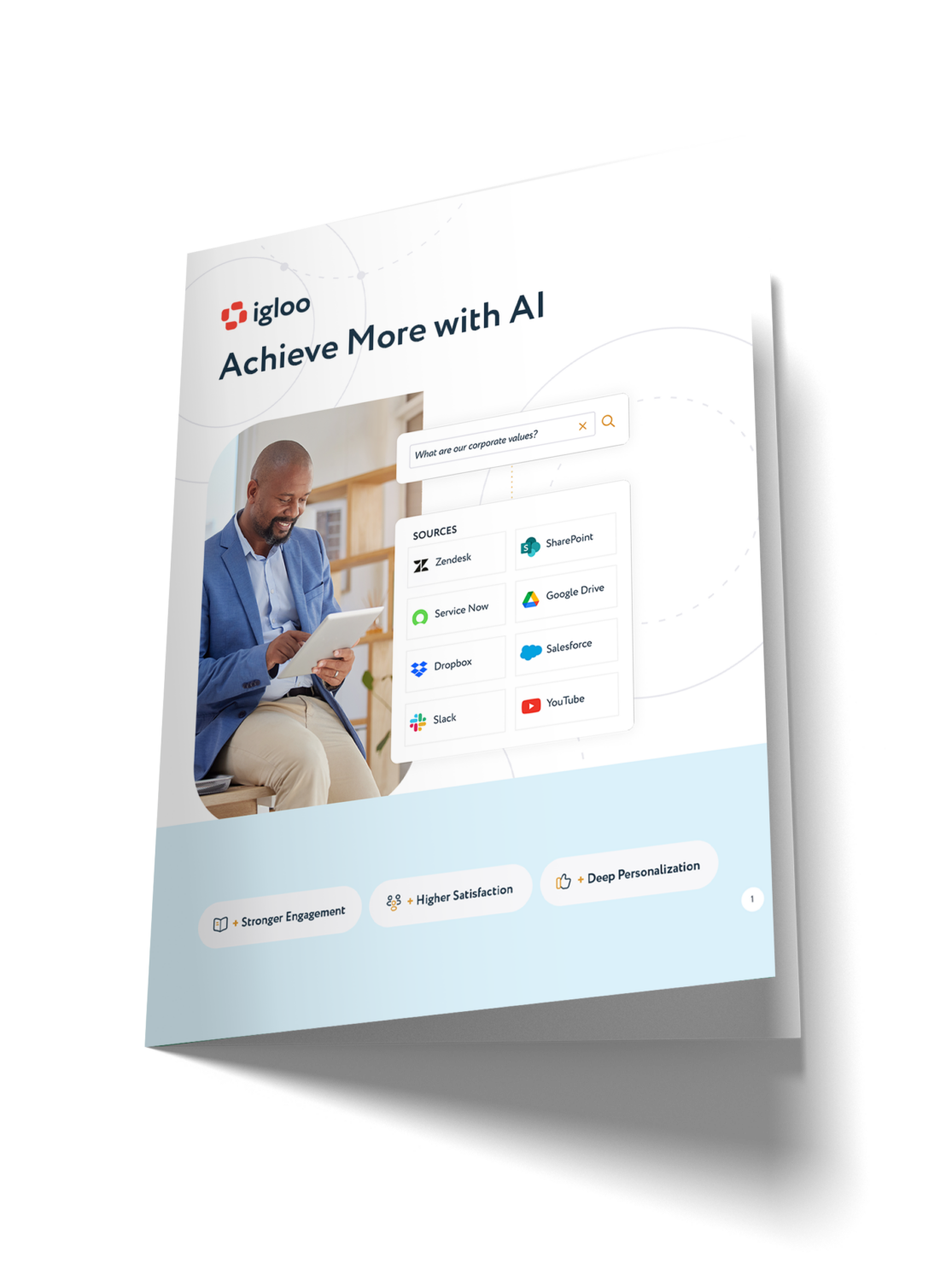What is Employee Engagement? (And How to Improve It!)
Employee engagement is the key to increased collaboration, productivity, enthusiasm, and motivation towards your organization’s goals. By creating a strong workplace culture with effective communications tools, you can drive engagement with your most critical objectives.


When employees are engaged, they don’t just do their jobs—they contribute, collaborate, and care about your organization’s success. The employee engagement definition centers on the emotional and psychological connection employees have with their work, their team, and the company. It’s more than just job satisfaction—it’s about taking initiative, solving problems, and feeling aligned with the company’s mission.
And the impact is real. According to Gallup, highly engaged teams see 23% higher profitability and 81% less absenteeism compared to disengaged teams. When employees feel valued and supported, they bring more energy and enthusiasm to their roles.
So, how can organizations create this type of workplace? In this guide, we’ll explore the key drivers of engagement, how leadership plays a role, and how employee engagement solutions can help organizations create a workplace where employees feel motivated, heard, and excited to contribute. Whether your goal is to boost retention, improve productivity, or build a more connected workforce, you’ll find actionable strategies to make it happen.
Why is Employee Engagement in the Workplace Important?
Engaged employees bring more creativity, energy, and commitment, leading to stronger results. On the other hand, disengaged employees often do the bare minimum, avoid collaboration, and may even negatively impact team morale.
For example, in a manufacturing plant, an engaged worker might proactively suggest efficiency improvements on the production line, while a disengaged employee simply follows instructions without considering process enhancements.
In hospitality, an engaged hotel manager might introduce a new guest experience initiative, while a disengaged one sticks to the bare minimum. Over time, disengagement spreads—leading to higher turnover, safety risks, and operational slowdowns that impact both employees and customers.
Benefits of Employee Engagement
Engaged employees don’t just show up—they drive success. When employees feel valued and motivated, businesses see measurable improvements. Let’s explore some employee engagement benefits.
- Higher Productivity – Engaged teams are more efficient, proactive, and innovative in their roles.
- Lower Turnover – Employees who feel connected to their work and company stay longer, reducing hiring costs.
- Better Customer Experience – Motivated employees provide better service, increasing customer satisfaction.
- Stronger Workplace Culture – Engagement fosters collaboration, trust, and a positive work environment.
- Fewer Absences – Engaged employees are more committed and take fewer sick days.
- Greater Innovation – Employees who feel heard and valued contribute fresh ideas and creative solutions.
- Higher Safety Standards – Engaged employees are more aware of safety protocols. This reduces workplace accidents.
- Improved Business Performance – Companies with engaged employees consistently outperform their competitors.
Prioritizing engagement isn’t just about morale—it’s a strategic advantage.
Key Drivers of Workplace Employee Engagement
Creating an engaged workforce doesn’t happen by accident. Building a workplace where employees feel valued, connected, and motivated to do their best work takes intentional effort. Some of the biggest engagement drivers include strong leadership, a supportive culture, open communication, and opportunities for career growth.
Leadership and Organizational Support
Leadership is one of the biggest influences on how much workers are participating. When managers are supportive, transparent, and approachable, employees are more likely to feel valued and motivated.
Trust and open communication between employees and leadership are key. Employees want to feel like their opinions actually matter and that leadership is invested in their growth. Organizations that focus on leadership development and prioritize employee well-being see increased employee engagement and motivation at work.
Workplace Culture and Values
A strong digital workplace culture is a game-changer for engagement. Employees who feel connected to their company’s values are more motivated to contribute and go above and beyond in their roles. Recognition and appreciation also play a huge part—when employees know their hard work is valued, they stay motivated.
Simple gestures like shout-outs in team meetings, employee appreciation events, and peer recognition programs can make a big impact. When people feel seen and appreciated, they’re more motivated to do great work.
Communication and Employee Feedback
Engagement flourishes when employees feel heard. That’s why two-way communication is crucial—employees need opportunities to voice their opinions, share ideas, and provide feedback. You can create a thriving, engaged workplace by implementing internal communication best practices tailored to your workforce’s needs.
Companies that regularly use employee engagement survey questions and leadership check-ins can catch engagement issues early and take action. Employees who feel their voices are heard and valued are far more likely to stay engaged.
Career Growth and Development Opportunities
Nobody wants to feel stuck in their career, and a lack of opportunity is usually a common cause of employee turnover. Employees are much more engaged when they see a clear path for growth and development. Offering mentorship programs, leadership training, and professional development opportunities gives employees a reason to stay invested in their work.
Encouraging continuous learning and skill-building benefits employees and strengthens the entire company. When people feel like their careers are progressing, they bring more energy, innovation, and dedication to their roles.
Employee Engagement Strategies
Improving involvement starts with intentional approaches to employee engagement. Here are a few ways you can build a more motivated workforce:
Recognize and Reward Employees
A little recognition goes a long way. Whether it’s a simple thank-you, a bonus, or an employee of the month program, recognition helps employees feel valued and appreciated.
Personalize the Digital Employee Experience
With remote and hybrid work becoming the norm, companies must create personalized digital experiences for their employees. Customizable dashboards, AI-driven career development tools, and easy-to-use collaboration platforms make a big difference in keeping employees connected and engaged.
Empower Your Workforce to Support Each Other
Strong workplace relationships improve engagement. Encouraging teamwork, cross-departmental projects, and peer mentorship programs helps employees feel supported and connected. When employees trust and rely on one another, engagement improves.
Discover additional employee engagement best practices →
How to Improve Employee Engagement
Building a highly engaged workforce starts with understanding what truly motivates employees. Organizations can follow these steps to create a more engaged and motivated workforce:
- Build trust through transparency
Keep employees informed about company goals and decision-making to strengthen commitment. - Encourage autonomy
Give employees ownership over their tasks and the flexibility to work in ways that suit their strengths. - Foster a sense of belonging
Use team-building activities, mentorship programs, and social initiatives to strengthen workplace relationships. - Invest in growth and development
Offer upskilling opportunities, coaching, and challenging assignments to keep employees engaged and progressing. - Leverage modern engagement tools
Use employee engagement software to track feedback, measure sentiment, and continuously improve workplace culture.
By following these steps, you can create an environment where employees feel valued, motivated, and excited to contribute.
How Employee Engagement Software Helps Businesses Succeed
Employee engagement software like Igloo Software transforms how companies connect and motivate teams.
- Intranet solutions inform employees of company updates, resources, and collaboration tools.
- Communication platforms (messaging, video conferencing, recognition tools) foster real-time teamwork—especially for remote and hybrid employees.
- Survey tools track engagement through pulse surveys and anonymous feedback, helping companies address issues early.
By investing in the right technology, businesses create a culture where employees feel valued, connected, and inspired to contribute—boosting retention and productivity.
Challenges in Employee Engagement
Keeping employees engaged isn’t always easy—especially with today’s diverse workforce. One common challenge is ensuring every worker feels connected, regardless of their role or work environment. For example, deskless workers—like retail staff and field technicians—often miss out on company-wide emails, intranet updates, or team meetings simply because they’re not at a desk. Without the right tools, they can feel out of the loop, which impacts motivation and job satisfaction. Mobile-friendly communication, on-the-go training, and regular in-person check-ins help bridge that gap.
Another challenge is helping employees see the bigger picture. When workers—whether on the floor, in an office, or at home—don’t understand how their efforts contribute to company goals, motivation dips. Strong leadership, clear communication, and regular feedback make a huge difference in keeping teams aligned and engaged.
Future Trends in Employee Engagement
The workplace is evolving, and so are the strategies for keeping employees engaged. As businesses adapt to new technologies and changing workforce expectations, several key trends are shaping the future of employee engagement.
AI-powered Engagement Tools
The AI digital workplace is revolutionizing how companies measure and enhance engagement. From predictive analytics that identify disengaged employees early to AI-driven chatbots that provide instant support, these tools help businesses proactively address workforce needs.
Remote and Hybrid Strategies
With remote and hybrid work becoming the norm, companies must rethink how they foster connection and collaboration. Investing in digital engagement solutions, flexible work arrangements, and virtual team-building activities ensures that employees stay connected and motivated no matter where they work.
Personalized Employee Experience
Personalized employee experiences are also gaining traction. Organizations are moving away from one-size-fits-all engagement strategies, opting for customized learning paths, career development programs, and recognition systems catering to individual needs.
Businesses that embrace these trends will create workplaces where employees feel valued, supported, and excited to contribute.
Take the Next Step Toward Employee Engagement with Igloo Software
Creating a motivated, connected workforce starts with the right tools and strategies. If your current approach isn’t driving the desired results, it’s time to rethink how you engage your teams.
Igloo Software helps businesses build a productive workplace by making communication, collaboration, and recognition seamless. Unlike basic engagement platforms, our platform is designed for flexibility and ease of use—ensuring that every employee, from desk-based teams to frontline workers, feels informed and valued.
If outdated tools or ineffective strategies are holding your workforce back, now is the time to upgrade to a solution that strengthens teamwork, simplifies workflows, and enhances productivity.
Ready to create a more engaged, high-performing workforce? Get started today.








